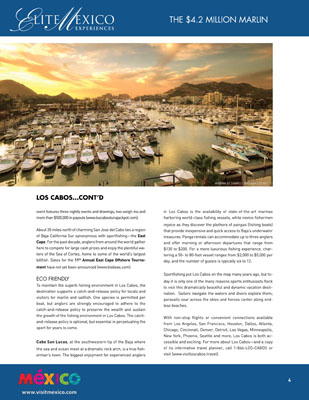

In fact, it is this new visual imagery that is utilized by the Tourism board to seduce new travelers. The theme of this particular ad is the unique experiences of fishing to be had while in Mexico. The experiences offered vary from regular fishing, fly-fishing, sport fishing, trophy angling, and participation in rich fishing tournaments. The first of the six page ad (displayed to the left) displays a half page photograph of a practically cloudless blue sky hovering above rocky green cliffs that run down into blue, crisp ocean water. Also pictured in the image is what appears to be a large deep sea fishing boat. Within the remaining pages of the ad, similar images of blue skies and ocean water, fishing boats, and sandy beaches are depicted. What could be more enticing than these beautiful images?
At this point I find it particularly interesting to point out how these analogous images of Mexico's fishing experiences pose drastically similar visuality to the ways that both French and British travel writers of the early 1800's successfully described the new tourist destination of Algeria (an island off the coast of France), and with these writings gained international exposure. In her article entitled: Algeria in and out of the frame: Visuality and Cultural Tourism in the Nineteenth Century , Deborah Cherry explains how Algeria became the "mise-en-scene" for an abundant amount of paintings, photographs, etc, as a kind of tourism "in which visual pleasures and ocular excitements were at a premium", significant too, were the exchanges between the relays between elite and popular forms, the intermediality of this visualization of Algeria. Also conspicuous was the incursion of the visual, the introduction of Western visual systems that not only framed but made intelligible a strange and unfamiliar land" (41). (41).



